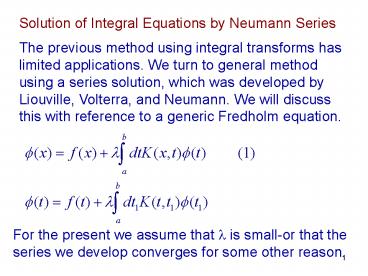Solution of Integral Equations by Neumann Series - PowerPoint PPT Presentation
1 / 23
Title:
Solution of Integral Equations by Neumann Series
Description:
Using the resolvent kernel calculated in the last equation, into the Neumann ... The connection to the Resolvent Kernel, is seen in Eq.(4): 22 ... – PowerPoint PPT presentation
Number of Views:1292
Avg rating:3.0/5.0
Title: Solution of Integral Equations by Neumann Series
1
Solution of Integral Equations by Neumann Series
The previous method using integral transforms has
limited applications. We turn to general method
using a series solution, which was developed by
Liouville, Volterra, and Neumann. We will discuss
this with reference to a generic Fredholm
equation.
For the present we assume that l is small-or that
the series we develop converges for some other
reason.
2
Then from Eq.(1)
3
4
(No Transcript)
5
From Eqs.(4)-(6) we have
Hence
6
Note the formal similarity of the solution in (9)
to the original integral equation
7
Note that (contrary to the initial motivation!!)
the convergence criterion does not depend on the
magnitude of l.
8
Uniqueness of solutions
9
The inequality in Eq.(14) is the SCHWARTZ
INEQUALITY in the form
10
(No Transcript)
11
(No Transcript)
12
Comments
13
Example Solve
14
We can continue this way and generate all the
iterated kernels.
15
We find that all of the nth iterated kernels are
equal, which allows us to write Eq.(2) as
16
Using the resolvent kernel calculated in the last
equation, into the Neumann series expansion we get
17
(No Transcript)
18
(No Transcript)
19
Using Eq.(1) in Eq.(2) then gives
20
(No Transcript)
21
The connection to the Resolvent Kernel, is seen
in Eq.(4)
22
This interchange of variables is what we referred
on slide 5 just before Eq.(8) on that page. We
can always rename the integration variables
(recognizing that they are dummy variables) in
such a way that the last integration is carried
out on the variable t as in Eqs.(6) and (7)
above. This step is the one which allows us to
write Eq.(8) on slide8 as
23
It might be expected, when the solution can be
found this easily, it can also be found another
method which does not require the use of
resolvent kernel. This leads us to the case of
DEGENERATE Or SEPARABLE kernels.

